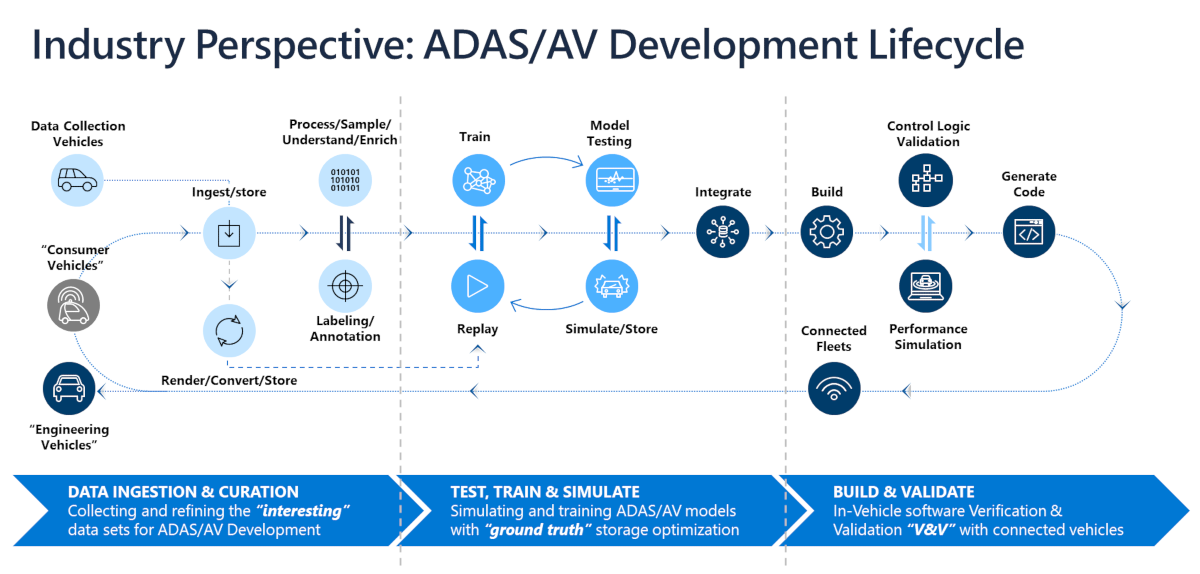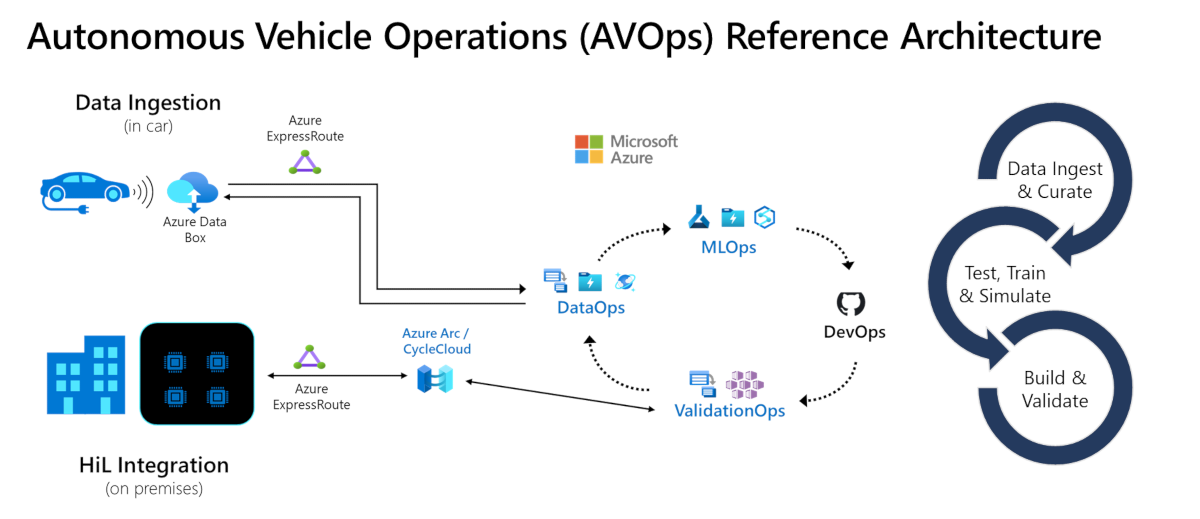Reference architecture for autonomous vehicle operations (AVOps)
Microsoft supports the autonomous and advanced driver assistance systems (ADAS) market through its Microsoft Azure services, edge services, and Artificial Intelligence AI technologies. Azure provides a scalable, secure, and reliable infrastructure for the storage, processing, and analysis of the vast amounts of data generated by autonomous vehicles. Azure services assist autonomous vehicle operations (AVOps) by providing capabilities to ingest, process, and serve exabytes of data. Microsoft AI capabilities are used for developing machine learning models for autonomous driving systems. Microsoft solutions help businesses in the automotive industry accelerate the development and deployment of autonomous and ADAS technologies.
A typical industry flow for the autonomous vehicle development lifecycle highlighting three key stages is as follows:
- Data ingestion and curation: Collection and refinement of carefully chosen data sets for advanced driver-assistance system/autonomous vehicle (ADAS/AV) development.
- Testing, training, and simulation: Simulation and training of ADAS/AV models across numerous ground truth scenarios.
- Build and validation: In-vehicle software verification and validation with connected vehicles.
Current challenges
Mobility companies confront a series of pivotal challenges when they navigate the complex landscape of autonomous capabilities and vehicle original equipment manufacturers (OEMs):
- Data management intricacies
- Seamless hardware-software integration
- Simulation accuracy
- Regulatory compliance
- Cybersecurity concerns
- Algorithm optimization
- Security infrastructure
- Orchestration of collaboration within the diverse autonomous vehicle ecosystem
Our goal is to address the challenges involved with creating a back end to allow an autonomous vehicle solution at scale through a reference architecture called autonomous vehicle operations (AVOps). AVOps is an end-to-end reference architecture that addresses the key challenges while providing flexibility to work with various partners or in-house custom solutions.
Benefits of AVOps
Microsoft AVOps supports autonomous driving by placing a heavy emphasis on accelerating efficiency and improving safety verification and validation, while integrating multiple development processes and environments into a unified platform. AVOps, when combined with critical partner solutions, facilitates the acceleration of autonomous driving workloads and computational capabilities to the cloud, saving cost and time while reducing complexity in the process.
AVOps accelerates autonomous vehicle development by addressing the following key areas:
- Streamlines engineering development into a single repository, data lake, and workflow.
- Automatically builds and tests commits for faster bug detection.
- Accelerates innovation through shared code, data, models, and training pipelines.
- Automates the entire process from code commit to production.
- Monitors pipelines, infrastructure, and products in production for anomalies.
- Replicates the exact vehicle models in the cloud to accelerate time to market.
AVOps reference architecture
AVOps implements an autonomous driving development lifecycle consistent with an industry-standard autonomous vehicle development flow. The digital testbed for ADAS/AV development integrates all development processes into one platform, from DataOps, MLOps, and DevOps to ValidationOps.
The AVOps architecture includes the following four main elements.
- DataOps: Ingests measurement data such as videos, images, lidar, and radar, curates and extracts data, and labels data. Learn more about DataOps here: DataOps for autonomous vehicle operations.
- MLOps: Trains algorithms, such as perception models and post-perception models.
- ValidationOps: Validates autonomous driving functions based on trained models and raw ground truth data. Learn about ValidationOps here: Validation operations for autonomous vehicle operations.
- AVOps centralized functions: Provide overarching functionalities like metadata search, data catalog, overall orchestration, platform governance, and standardized infrastructure templates.
Autonomous vehicle development requires considerable storage, high performance compute, and data management across many internal engineering/IT teams and partners to find, curate, enhance, label, and manage the most interesting data sets through direct vehicle data collection or synthetically generated data for critical AI/ML training. AVOps reference architecture allows partners/OEMs to accelerate their development of autonomous vehicles.
Enhancing AVOps with generative AI
Generative AI can help reduce the complexity, cost, and time of developing and testing autonomous driving systems. For more information, see Enhance AVOps with generative AI.
Enabling Microsoft technologies
Key Microsoft technologies that enable the AVOps reference architecture include:
| Enabling technology | Description |
|---|---|
| Azure AI Foundry | Azure AI Foundry is a trusted platform that helps developers to drive innovation and shape the future with AI in a safe, secure, and responsible manner. For example, in the context of AVOps, Azure AI Foundry helps in integrating Language Models with vision capabilities such as Azure OpenAI GPT-4o to perform offline scene analysis. |
| Azure Blob Storage / Azure Data Lake Storage | A massively scalable object storage for any type of unstructured data-images, videos, audio, documents, and more-easily and cost-effectively. |
| Azure Data Factory | Azure Data Factory performs extract-transform-load (ETL) via batch compute and creates data-driven workflows to orchestrate data movement and transform data. |
| Azure Databricks | Azure Databricks is a unified, open analytics platform for building, deploying, sharing, and maintaining enterprise-grade data and analytics solutions based on Spark at scale |
| Azure Batch | Azure Batch runs large-scale batch inference for validation within a Resim framework and for other high performance computing (HPC) data-driven workloads that require a native scheduler. |
| Azure Arc | Azure Arc is a bridge that extends the Azure platform to help you build applications and services. |
Next steps
Get started with the following article:
You can then refer to the following articles:
- Learn more about DataOps for autonomous vehicle operations
- Learn more about ValOps for Autonomous Vehicle Operations
- Accelerate your cloud adoption and migration journey with Microsoft cloud adoption framework for Azure

